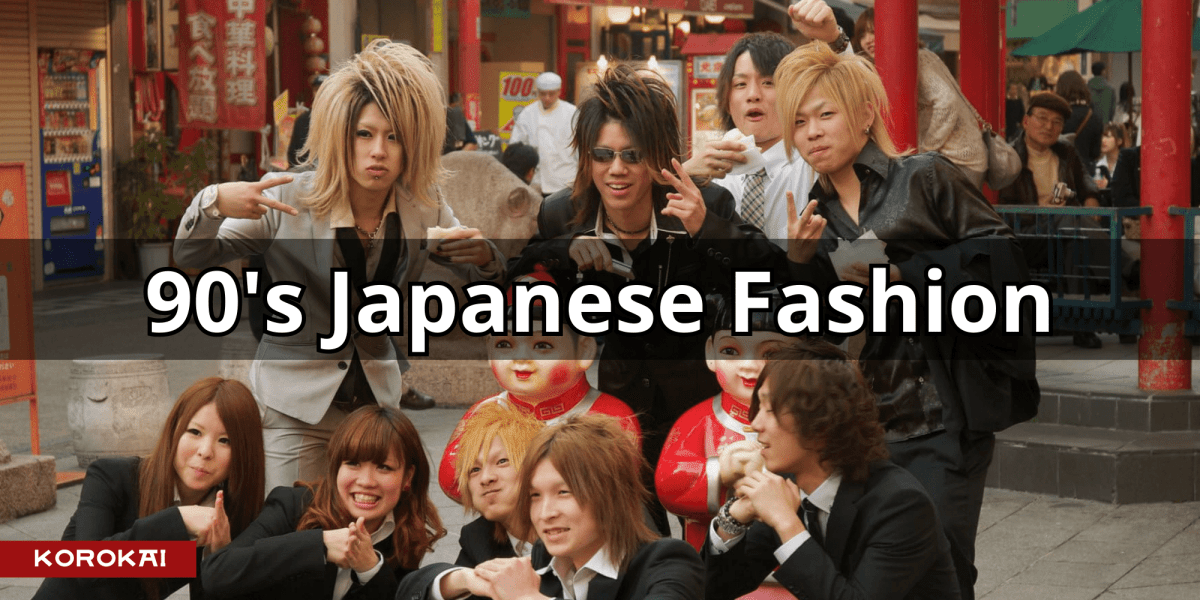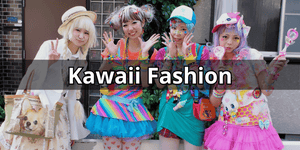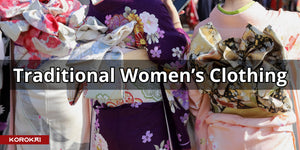The 90s in Japan were an effervescent and innovative period for fashion. The decade saw the emergence of bold styles, influenced by music, media and socio-cultural changes. From the famous Takeshita street in Harajuku to J-Pop idols and the rise of fashion magazines, each element helped shape an iconic era in Japanese fashion. In this article, we explore the key moments, trends and influences that made this decade a memorable era in Japanese fashion history.
Introduction to the 90s in Japan
The 90s in Japan represented a period of profound transformation, marked by the blending of tradition and modernity. Following the economic bubble of the '80s, the next decade saw the country navigate through a recession, bringing with it major sociocultural changes. Despite the economic challenges, it was a time of creative effervescence when art, music and, in particular, fashion flourished, reflecting the aspirations and concerns of a youth in search of identity and meaning.
In Tokyo, neighborhoods like Harajuku and Shibuya became the epicenters of this fashion revolution, welcoming a generation that sought to express its voice through bold, innovative styles. The streets were the scene of spontaneous fashion shows, where every outfit told a story, every accessory had a meaning. Fashion quickly became the language of youth, a means of exploring, challenging and, ultimately, defining what it meant to be young in '90s Japan.
The importance of Takeshita Street

In the heart of Tokyo, nestled between towering skyscrapers and bustling streets, Takeshita Street in Harajuku became synonymous with bold fashion, innovation and boundless creativity during the 90s. Much more than just a shopping street, Takeshita quickly became the soul of Tokyo's young fashion scene, offering a space where freedom of expression reigned. It was a place where traditional norms were set aside, and every street corner was a spectacle of color, texture, and individuality.
Every Sunday, the street was invaded by young people dressed in everything from Visual Kei-inspired gothic outfits to Lolita costumes, punk styles and Western-influenced street fashions. The boutiques lining Takeshita were both sources of inspiration and platforms for budding designers, offering whatever the imagination could conceive. For many, Harajuku and its famous Takeshita street symbolize the spirit of 90s fashion in Japan: bold, non-conformist and always evolving.
The Influence of Popular Culture

Popular culture in Japan in the 90s played a major role in the way fashion developed and transformed during that decade. J-Pop idols such as Hikaru Utada and Namie Amuro exerted an enormous influence on young people. Their hairstyles, clothing choices and even make-up were scrupulously copied by fans eager to emulate their favorite stars. What's more, with the rise of technology and the advent of music videos, idols' looks became more accessible and visible, further strengthening their impact on fashion.
At the same time, the popular anime and manga of the 90s, such as "Sailor Moon" or "Neon Genesis Evangelion", also helped shape the fashion landscape. School uniforms, costumes, kawaii clothes and distinctive character accessories quickly became fashionable into Japanese youth culture. Popular culture was not only a source of inspiration; it was actively integrated and reinterpreted in everyday clothing, testifying to the dynamic interplay between media, music, and fashion.
Emblematic Japanese Styles of the Decade

The 90s in Japan were an explosion of fashion creativity, with a myriad of styles emerging and establishing themselves as enduring trends. Each style had its own nuances, its own roots, reflecting the diverse cultural influences and societal evolutions of the time. Let's take a look at some of these emblematic styles:
- Gyaru: Taking cues from California fashion, the Gyaru style embraced an aesthetic of tanned skin, bleached hair and an ultra-trendy wardrobe. These young women represented a new form of femininity, breaking with traditional norms while embracing a bold, confident attitude.
- Visual Kei: Going far beyond a simple look, Visual Kei is deeply inspired by the rock music scene, particularly bands like X Japan. With its dramatic make-up, bold hairstyles and theatrical outfits, it embodied a provocative and unique self-expression.
- Lolita: Evoking the elegance of the Victorian era, the Lolita style is characterized by full dresses, puffed petticoats, lace and floral motifs. Whether it's the darker Gothic Lolita or the softer Sweet Lolita, this style evokes a timeless innocence.
- Streetwear: Drawing inspiration from hip-hop culture and urban fashion, Japanese streetwear of the 90s featured loose silhouettes, bold logos and graphic patterns. It represented urban youth, connected to global trends while retaining a distinctly Japanese touch.
- Kawaii: Emerging as an embodiment of all things cute, the Kawaii style is centered on pastel colors, playful patterns, and cartoon-like characters. The trend took hold in various facets of Japanese culture, from fashion and accessories to stationery and decor.
90's Japanese Fashion Men and Women
During the '90s, the Japanese men’s and women’s fashion was a fascinating mosaic of styles. For men, the decade was marked by an eclectic mix of looks. Streetwear, influenced by brands such as A Bathing Ape (BAPE), dominated the scene, with oversized hoodies, camouflage patterns and high-top sneakers. The Urahara movement, a subculture centered around Tokyo's Ura-Harajuku street, also emerged, mixing American and Japanese fashion to create avant-garde streetwear styles. At the same time, a more elegant look, inspired by minimalism and streamlined designs, was also gaining in popularity. Well-cut suits, button-down shirts and elegant watches were the order of the day for the modern metropolitan man.
On the women's side, the 90s in Japan saw an explosion of subcultures and styles. The iconic "kogal style", for example, was characterized by pleated mini-skirts, white knee-high socks and deliberate tanning. Gyaru style on the other hand, were recognizable by their pronounced make-up, bleached hair and love of bling accessories. Alongside these bolder styles, women's fashion in the '90s also embraced minimalism, with streamlined garments, simple lines and neutral color palettes, reflecting the influence of designers like Rei Kawakubo and Issey Miyake. These varied styles offered women great freedom of expression, allowing them to explore and redefine their identity through fashion.
The Rise of Fashion Magazines
At the dawn of the 90s, a new trend was emerging in Japan: the meteoric rise of Japanese fashion magazines. These publications, brimming with polished images and stylistic advice, played a central role in the propagation of trends and served as a compass for many fashion enthusiasts across the country. Tokyo, in particular, with its bustling fashion ecosystem, became the birthplace of many magazines that would come to define the era.
FRUiTS magazine, for example, focused on the unique Harajuku scene, capturing the eccentric looks of young people strolling through the neighborhood. "Non-no" and "CanCam", on the other hand, were more focused on mainstream fashion, offering style guides for modern Japanese women. "Men's Non-no" approached men's fashion with sophisticated elegance. In addition to featuring the latest trends, these magazines often offered designer interviews, product reviews and beauty tips, making them invaluable resources for those seeking to hone their sense of style.
Transition to The 2000s
In the late '90s, Japanese fashion began to undergo significant transformations, reflecting both the country's socio-cultural changes and global trends. This period was marked by a transition to more sober, streamlined and minimalist looks, in contrast to the flamboyant, bold styles of the early part of the decade. The economic crisis of the '90s in Japan, known as the "lost decade", undoubtedly influenced this evolution, as consumers sought more timeless and durable clothing.
At the dawn of the new millennium, technology began to have a growing influence on fashion. With the rise of the Internet and the popularization of cell phones, trends could spread more quickly and young people had access to a global source of inspiration. This led to a fusion of styles, mixing traditional Japanese elements with Western trends. What's more, street fashion, already well established in places like Harajuku, continued to flourish, proving that despite the changes, Japan remained an essential leader in global fashion.
Conclusion
The fashion of the 90s in Japan left an indelible mark on the global fashion landscape. Fusing tradition and modernity, it revolutionized the way we perceive and adopt trends. As the decade drew to a close, the foundations were laid for a new era of creativity and innovation. These formidable years not only shaped fashion in Japan, but also inspired generations around the world, attesting to the power and influence of Japanese culture.












